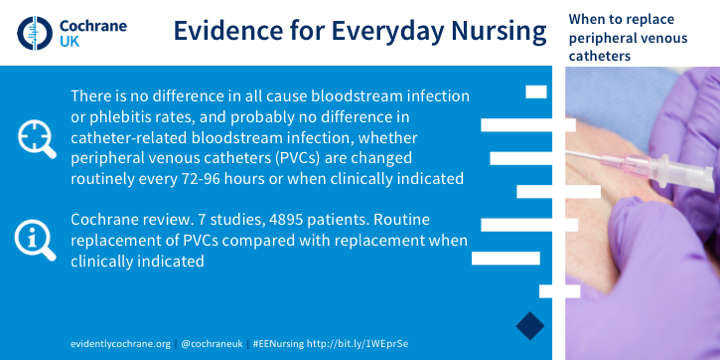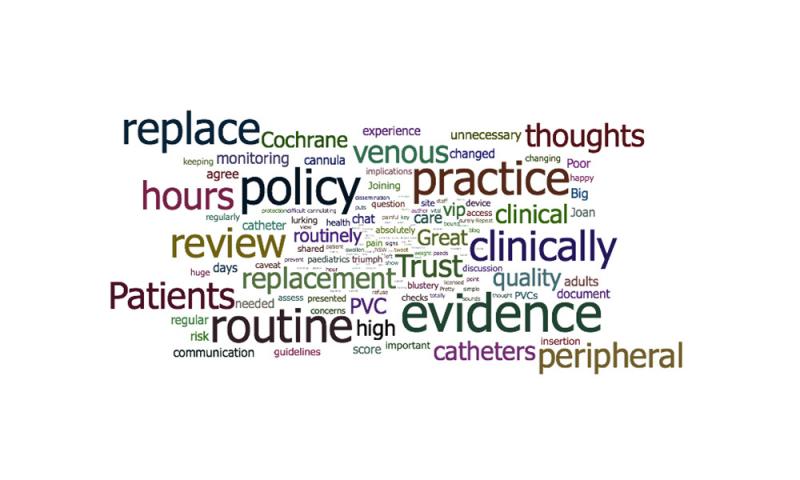

Reposted with permission from Evidently Cochrane
This blog by Sarah Chapman @SarahChapman30 reflects on how Cochrane UK shared Cochrane evidence on replacement of peripheral venous catheters. The blog was first published as an example of using social media to share research on the website of The HARTS of the possible project, which is exploring the possibilities of social media for health and research.
Brief synopsis
We used social media to share a newly updated Cochrane Review, with high quality evidence, informing and supporting the recommendation in UK and international guidelines that peripheral venous catheters (PVCs) should be replaced only when clinically indicated rather than routinely. Our primary target audience was nurses and we first shared this during the launch of our new series ‘Evidence for Everyday Nursing’ (#EENursing).
What did we do?
Across 2 weeks in November 2015:
- Summarized this research in an Evidently Cochrane blog, the first blog of our new series Evidence for Everyday Nursing #EENursing
- Guest-hosted a #WeNurses tweetchat on this research, with participation by two of the nurse-researchers who were authors of this review, to explore practitioners’ views on the evidence, whether current practice was evidence-based and whether it could support a change in practice if not.
- Published another Evidently Cochrane blog, summarizing and reflecting on the tweetchat
- Made a blogshot (see image below) giving a key message from this review and shared on Twitter, with a link to the full review, and posted it on Pinterest

Since then:
- Made a vlogshot - moving slides sharing the same information as a blogshot; shared on Twitter
- Blogshot and vlogshot shared repeatedly on Twitter, Instagram and Facebook, and made available for viewing, downloading and sharing on Tumblr
So what?
What worked well?
This blogshot is the most widely shared of all our blogshots. The blogshot format is proving popular; we know images work well on social media. The information is quick to access and to share, with a link to get to fuller information if desired. It will be quick and easy to update when the Cochrane review is updated. The #EENursing series ‘branding’ (hashtag and series blogshot template) makes it easier for people to spot that it might be of interest to them.
Joining with @WeNurses for the tweetchat was crucial. This enabled us to engage with an established community of nurses and to take advantage of the mechanisms that the WeCommunities have established for holding successful tweetchats, from promoting them in advance, providing pre-reading and questions to be addressed in the chat, running them smoothly, and gathering tweetchat data. Collaborative work like this also strengthens existing relationships, and we enjoy it! The tweetchat was lively, revealing and practice-changing; more of that below. It was worth the time it took to summarize key points from the conversation in a blog. This is a much easier way for people to catch up with a chat, including those who took part, than going through a stream of archived tweets. However, I was only able to do this because of the ‘raw’ data from the chat, captured by WeNurses.

What didn’t?
We put this blogshot, along with our others, on Pinterest, but then found that Pinterest wouldn’t support the link to the full review (or blog).
We originally included explicit reference to evidence quality according to GRADE, but have since removed this from all our blogshots as we realised that this won’t be understood by most people. Instead, we now use GRADE to inform the phrasing of the key message.
What was missing?
At the time, we shared very little on our Cochrane UK Facebook page. We have since learned that we get more people coming to our blogs from Facebook than from Twitter, so we now share the blogs, blogshot and vlogshot on Facebook too. We have recently started sharing our blogshots and vlogshots on Instagram instagram.com/ukcochranecentre and Snapchat.
Impact
Social media impact
The blog summarizing this review had more traffic from social media (as opposed to through Google searching) than any other Evidently Cochrane blog in the first six months after publication and both this and the blog about the tweetchat continue to be read and shared. The blogshot and vlogshot get multiple retweets when shared and the vlogshot does particularly well on Facebook. Facebook and Twitter are the two platforms where we have most engagement with nurses; conversation about the evidence is mostly on Twitter. We had lots of positive tweets about the way we shared this research and not only from nurses. One medical student tweeted that he might print out the blog and carry it round with him! The tweetchat had 63 participants sharing over 400 tweets, with a reach of 6,138,377, and it didn’t end there. Which bring us to…
Impact beyond social media
Evidence into practice
This is where it gets exciting! The impact we’re most interested in is whether it influenced practice. Providing best evidence to inform decisions and so improve health is the fundamental aim of Cochrane and so this underpins all we do. The tweetchat revealed wide variation in practice and two nurses tweeted their intention to take action as a result of learning about this evidence and discussing it with peers. We used Twitter to follow up what they did. One, an Infection Prevention Nurse, initiated a change in policy as a result and was waiting for the changes to be approved when we last heard. The other, a student nurse, was told by his ward sister that it was Trust policy but said he would be taking it up with his local infection prevention team.
Building relationships
When reflecting on the impact of our social media use, we also consider whether we have been able to make new connections or build on existing relationships. Having a tweetchat with WeNurses and enlisting their support in helping us launch the #EENursing series, as well as this research, no doubt increased our reach but also built on, and furthered, our relationship. We made new links on Twitter with individuals and groups working in infection prevention and vascular nursing.
Now what?
What were your learning points?
- Tweetchat: bringing together researchers (including authors of the review), nurses and practitioners from other disciplines in a tweetchat was valuable for their different knowledge and perspectives. Think beyond a single audience – using #WeMDT rather than #WeNurses may have attracted more from the multi-disciplinary team.
- Making information quick and easy to access, in a variety of formats and at different levels of complexity, increases the number of people likely to see, share and use it.
- Research on common practices, shared in easy formats on social media, is useful to healthcare practitioners.
- Summarizing tweetchats in a blog is time-consuming but worth doing.
- Metrics such as the number of blogs views, or retweets, give us a sense of how popular something is, or how widely seen, but don’t tell us very much. When someone tells us that it has changed what they do, that is a fabulous example of impact. It needs to be captured and, ideally, followed up.
What will you do next for this piece of work?
Update all the social media products when the review is updated, and keep sharing them. We would like to have a blog from the nurse who initiated a change in policy, telling this story.
What will you do next for other pieces of work?
More blogs, where possible combining an evidence summary with a reflection from practice, on key clinical topics and practices, along with related products (blogshots, vlogshots). More tweetchats, to be followed by a summary blog and an attempt to follow up stories of ‘real life’ impact.
We are seeking nurses’ views about the usefulness of the ways we share research through social media and how we could improve. We will take the learning from this to develop the series, with a view to evaluating and revising our other ‘Evidence for Everyday’ series (for midwives, allied health professionals and patients/people making health choices).
What will you ‘drop’ for future work?
We dropped Pinterest when we realized it didn’t support the links.
Anything else to comment upon?
Keeping the content of our social media products up to date is important for us. Cochrane reviews are periodically updated and we want to keep sharing content and for people to know that it relates to the latest evidence. This is quick and easy for the blogshots and vlogshots, but more complicated for the blogs.
Relationships are vital! Linking with the WeCommunities helps us enormously in sharing our work widely and quickly. More generally, Twitter continues to be a brilliant place to discuss research and to network, with online connections sometimes leading to new collaborations.
It’s important to watch and respond, not just share and run! We sometimes add the most value by spotting that someone is looking for information that we can provide, or by responding to feedback on what we’ve shared. There was a valid criticism on Twitter of an image of an asthma inhaler accompanying our blog; we changed it.
How could HARTS take this forward?
It would be great to see elements of this adopted, and possibly adapted, in other contexts. Blogshots began with an idea by HARTS’ Teresa Chinn and are easily adapted for other purposes; @ZotVet is doing this within the veterinary community!
A blog with dual perspectives, and bringing together people with a variety of expertise in a chat, then pulling out key points, would work well in many contexts.
It seems that all of us using social media in a professional context need to be able to demonstrate impact, but working out how best to measure or capture this is a considerable challenge – one we will continue to pursue. This is the element that is common to all three strands of the HARTS Rainbow Prism Model and I am really interested to see what we discover about how this can be done.

